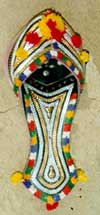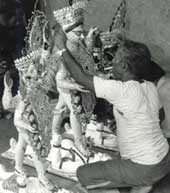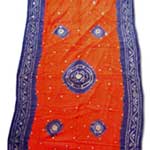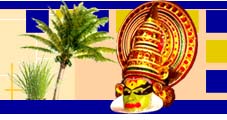|
Traditional Crafts
In a country as diverse and complex as India, it is not surprising
to find that the traditional art here reflect the rich glories of
the past, the culture, traditions and values relative to geographic
locations and the numerous distinctive manners and habits that will
always remain truly Indian.
The rich craft heritage of India is unique and diverse as its customs
and traditions. Each part of the country has its own unique cultural
ethos, which is manifested in the handicrafts of that particular
region. Indian crafts and handicraft traditions are influenced by
local topography, climate, and socio-religious factors. These craft
traditions have withstood the ravages of time and numerous foreign
invasions and continue to flourish till date owing to the assimilative
nature of Indian culture and broadmindedness of the craftsmen to
accept and use new ideas.
Indian craft tradition has no parallel in the world, in diversity
as well as in technique and use of materials. The craft traditions
of India vary from region to region. These crafts not only cater
to the day-to-day needs of the people but are also used for decorative
and religious purposes.
Given below few of the exclusive Traditional Crafts of India, (click
for more information)
Basket Weaving and Mat Making
Man has know n
basket weaving and mat making crafts since the dawn of history.
It is thus one of the oldest craft forms. The tribals do most of
the basketry and mat making work in India. The tribals, to reflect
their art and culture have used cane and bamboo since ancient times.
The materials used for basket, mat weaving and cane work are simple
and found in abundance. Locally available natural material like
grass, reeds, leaves etc is used for mat and basket making. Jute,
coir and bamboo are also used in basketry and in making
mats. States like Bihar,
Orissa,
Tamil
Nadu,
Madhya Pradesh and the North-Eastern states like
Sikkim,
Meghalaya
are known for their basket weaving and mat making traditions. The
production of cane furniture is on the rise these days. n
basket weaving and mat making crafts since the dawn of history.
It is thus one of the oldest craft forms. The tribals do most of
the basketry and mat making work in India. The tribals, to reflect
their art and culture have used cane and bamboo since ancient times.
The materials used for basket, mat weaving and cane work are simple
and found in abundance. Locally available natural material like
grass, reeds, leaves etc is used for mat and basket making. Jute,
coir and bamboo are also used in basketry and in making
mats. States like Bihar,
Orissa,
Tamil
Nadu,
Madhya Pradesh and the North-Eastern states like
Sikkim,
Meghalaya
are known for their basket weaving and mat making traditions. The
production of cane furniture is on the rise these days.
Jute and coir are relatively new materials, which are being used
in various making various items. Coir fiber is obtained from coconut
husk after a lengthy process.
Kerala is the largest producer coir products, which range
from mats, mattresses, pillow-covers, carpets, bags, wall hangings
etc. Coir items and popular due to their durability. Jute, known
as the golden fiber is the cheapest natural fiber. A variety of
utilitarian items are created using jute. West
Bengal is the largest producer of a variety of jute crafts,
which range form: mats, floorings, cushion covers, table covers,
bags, garments, stuffed toys etc.
Top
Carpets and Floorings
Carpets and Floorings are an integral part of Indian homes. Carpets
and floorings are made up of a variety of material, ranging from
wool, cotton, silk, jute, coir,
bamboo and grass. The Mughals introduced the art of
carpet weaving in India and set up centers at Ara,
Delhi
and Lahore to train and produce carpets of Persian style
following the designs of Kirman, Isfahan, Herat, etc. The contemporary
Indian craft of carpet weaving is the offshoot of the Mughal tradition
and follows the Persian style of carpet weaving.
Kashmir
is known for its silk carpets while Bhadohi- Mirzapur belt
in Uttar
Pradesh is the leading hand knotted woolen carpet-producing
center in the country. Tufted woolen carpets are gaining popularity
these days. Gabbe woolen carpets, chain stitch rugs and carpets,
and namdas are also made in India.
Woolen durries and mats are other floorings used in India. Durries
not only lend colour to the décor of the house but they are
also cheap. Mats are made out of a variety of readily available
material like, bamboo, grass, jute, coir etc. India has a varied
mat making tradition. Bihar,
Orissa, Tamil
Nadu, Kerala
, West
Bengal and Norh-Eastern states all have distinct
mat weaving traditions of their own.
Top
Clay Crafts and Pottery
Indian has a rich tradition of clay crafts and pottery throughout
the country. There is hardly any Hindu festival or ritual, which
is complete without the use of earthen lamps or diya. The terracotta
tradition is the continuation of the Indus valley traditions that
date back 5000 years. India also has an age-old tradition of clay
toys and terracotta figures. Terracotta work is centered in the
states of West
Bengal, Orissa
and Madhya
Pradesh. West Bengal is also known for unfired clay sculptures.
The Bankura terracotta horse is popular all over India. Translucent
blue pottery is made in Delhi
and Jaipur.
Clay crafts are deeply rooted in the tribal societies of our country.
Gems And Jewelry
The discussion about Indian crafts and culture is meaningless without
the reference to gems and jewelry. Indians have been obsessed with
use of gems and jewelry from the beginning of Indian civilization.
This obsession is not only fuelled by religious practices and myths
but also by economic and s ocial
reasons ocial
reasons
Jewelry made of gold, silver, copper, terracotta
and beads have been found from various sites belonging to
the Indus valley civilization. Though there is some reference to
ancient jewelry making, the Mughals rulers took jewelry making to
new heights. Not only Islamic designs and motifs were incorporated
into the Indian jewelry tradition, but new techniques like enameling,
damascening, engraving and inlaying were introduced by them. The
richly adorned and embellished peacock throne of the Mughals is
the finest example of their excellence in working with precious
metals and stones.
There is a profusion of jewelry styles across the country. All
sorts of material like gold, silver, copper,
coral, pearl, precious and semi-precious
stones are used in making jewelry. Each region has its own distinct
flavor, which reflects local tradition and influences. Rajasthan
and Delhi
are known for meenakari and enameling. Pearl jewelry is common in
Maharashtra
and Andhra
Pradesh. Gold and silver jewelry is common to most regions
of the country. Silver predominates most of the traditional jewelry
of the tribals.
Gems and semi-precious stones have been used by Indians not only
in jewelry pieces but also for medicinal and astrological reasons.
India is the largest importer of gold in the world and it has the
largest gem cutting and polishing industry in the world. Top
Glassware
Glass has fascinated human beings since the dawn of civilized world.
Glass is not only used in making utilitarian items such as bowls,
bottles, lampshades, perfume bottles, bangles etc, it is also used
for making small decorative items such as toys, beads, paintings
etc. Ferozabad and Saharanpur in Uttar
Pradesh are known for their glassware.
Leather Craft
Indians have known the art of tanning since the time of the Indus
valley civilization. Popular leather items are footwear, bags, saddles
etc. Kohlapur is known for its chappals. Rajasthan
is the home of decorated leather products; Mojdis or thick
shoes are made of locally cured leather, they are decorated with
silk, metal embroidery and beads.
Bikaner and Jaisalmer
produce decorative saddles for horses and camels. West
Bengal is known for it's decorated leather bags. Ornamental
work on leather can found in crafts of Punjab,
Kashmir and Karnataka.
Items like lampshades, pouches, stuffed toys etc are also made of
leather.
Metal Crafts
Indian craftsmen had mastered the art of metallurgy 5000 years back.
The lost wax process was known to the ancient craftsmen in making
pots and sculptures. Metal craft is an integral part of the Indian
ethos: pots, utensils, vessels, tools, weapons etc have been made
out of a variety of material like iron, copper, bronze,
bell metal, white metal, silver etc. The Ladakh
region of Kashmir
is known for traditional vessels made out of iron and brass. Moradabad
is world famous for its array of utilitarian brassware. Engraving
using traditional motifs is also done on items made in Moradabad.
Making of bronze sculptures is common in Palitana in Gujarat,
Vishnupur near Calcutta,
Balasore in Orissa
and all the Southern states.
Painting
Painting is one of the earliest known activities of man and India
is no exception to that. The earliest known paintings can be found
in the Bhimbetka caves of Madhya
Pradesh. The Ajanta caves is another milestone in
the Indian history of painting, not only were the artists rendering
realistic images, but they were also well versed with the art of
making frescoes. The miniature paintings under the Mughals was the
high point of painting in the yester years. Different areas of India
have different painting traditions. They differ from each other
in technique, style, use of material and rendering of the subject,
owing to regional and past influences. Ladakh
is known for its Thanka paintings. Tanjore is known
for ornate glass paintings. The different miniature schools
of Rajasthan
lend color to this arid land. India also boasts of numerous tribal
and folk painting traditions: Gujarat,
Madhya Pradesh,
Maharashtra,
Bihar,
Orissa,
west
Bengal have their own unique painting styles.
Top
Paper -Mache
Papier-mâché articles are made of waste paper and are
molded according to requirement. A large number of utilitarian items
are made from Papier-mâché. Kashmir
is well known for day-to-day articles made from Papier-mâché.
Boxes, trays, pots, vases etc are made of Papier-mâché
and then they are painted in bright colors. Large items also have
gold and silver leaf applied to them. Madhya
Pradesh is known for Papier-mâché t oys
and other articles. Punjab
is also known for Papier-mâché utensils and storing
vessels. oys
and other articles. Punjab
is also known for Papier-mâché utensils and storing
vessels.
Shola Pith
Shola is a plant that grows in marshy areas. The shola pith has
been utilized in Bengal,
Orissa
and Assam
as art decorations. Here decorations for deities are made from shola
pith. Craftsmen in Tamil
Nadu are famous for structurals in pith products. Pith flowers
are made in Karnataka
and Maharasthra.
Textile Tradition
The people from the Indus valley civilization laid the foundation
of weaving traditions of our country. Ancient texts and archaeological
findings verify the rich textile tradition of India. Indian textiles
have been popular abroad since ancient times. The legendary muslins
from Dacca were the high point of this craft form. Weaving
in India has been conditioned by geographical, cultural, economic
and social factors. A variety of material like silk, cotton, wool,
jute etc is used by the weavers.
Sari weaving is the main weaving tradition of India. There
is a mind-boggling array of styles and brocades throughout the country,
which are rich in design and color. Mysore, Banaras,
Surat, Kanchipuram, Paithan, Chander
etc are some of the important sari weaving centers. Woven woolen
items are also popular in India. Woolen Pashmina and Shahtoosh
shawls of Kashmir
are world famous. Woolen shawls from North-Eastern states
and Himachal
Pradesh are also popular.
India is known for decorative textiles. Embroidery is the
beautification of woven material with various types of stitches.
A number of embroidery styles flourish in India, they not only vary
in technique but also in design and use of fabric. Punjab,
Gujarat,
Karnataka and Uttar
Pradesh are main centers of embroidery. Appliqué
work is also practiced widely in India. Gujarat, and Punjab
are known for rich appliqué work. The tribals of Rajasthan,
Orissa
and Andhra pradesh also practice this craft from.
Tie and dye (Bandhani), hand printing and block printing
techniques are common across the country. The Tie and dye technique
of printing in particular is popular in the states of Rajasthan,
Madhya Pradesh and Andhra
Pradesh. A lot of utilitarian items like bed cover, 7sheets,
cushions, spreads, garments, curtains etc are created using these
traditional textile-printing methods.
Woodcarving and Stone Carving
Indian craftsmen have perfected carving in all its manifestations
using a variety of raw material ranging from wood, stone,
horn, coconut shell etc. Exquisite woodcarvings depicting
gods and goddesses and mythological figures are a common place amongst
the carved wood products. Woodcarving is popular in the states of
Kashmir, Orissa, Madhya
pradesh and the Southern states. The material varies
from walnut, redwood, sandalwood and teak
etc. Stone carving too is popular amongst Indian crafts and is practiced
throughout the country. Delicate marble jali work from Rajasthan
and Agra
is as popular as the carved sculptures from Orissa
and South India. Carving on coconut shells is done in the state
of
Kerala. Shallow relief carving is also done on conch
shells.
Top
Information on Traditional Crafts, arts, handicrafts of Bharat Heritage - India
|






 n
basket weaving and mat making crafts since the dawn of history.
It is thus one of the oldest craft forms. The tribals do most of
the basketry and mat making work in India. The tribals, to reflect
their art and culture have used cane and bamboo since ancient times.
The materials used for basket, mat weaving and cane work are simple
and found in abundance. Locally available natural material like
grass, reeds, leaves etc is used for mat and basket making. Jute,
coir and bamboo are also used in basketry and in making
mats. States like
n
basket weaving and mat making crafts since the dawn of history.
It is thus one of the oldest craft forms. The tribals do most of
the basketry and mat making work in India. The tribals, to reflect
their art and culture have used cane and bamboo since ancient times.
The materials used for basket, mat weaving and cane work are simple
and found in abundance. Locally available natural material like
grass, reeds, leaves etc is used for mat and basket making. Jute,
coir and bamboo are also used in basketry and in making
mats. States like 
 ocial
reasons
ocial
reasons
 oys
and other articles.
oys
and other articles. 